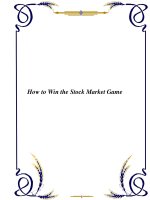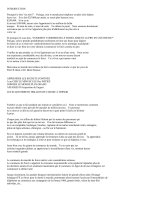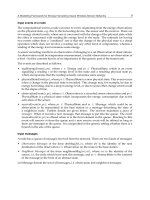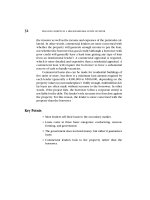How to trade the new single stock future Part 2 ppt
Bạn đang xem bản rút gọn của tài liệu. Xem và tải ngay bản đầy đủ của tài liệu tại đây (221.65 KB, 16 trang )
❚ The Origins of Stock Trading
Those who believe that the futures markets have been riddled
with scandals are likely unaware that the history of stock trading
in the United States was also grounded in scandals. Although the
trading of shares in public companies did not originate in the
United States, stock trading was very popular in America in the
1700s. At that time brokers gathered near Wall Street in Lower
Manhattan to trade stocks alongside a 12-foot-high stockade.
Although few (if any) formal rules and regulations governed stock
trading, a radical change took place in 1798 as a result of a finan-
cial panic caused by William Duer. Duer had overextended his
debts to several banks, which ultimately caused them to fail. Duer
was sent to debtors’ prison for his part in the financial debacle. To
help prevent similar problems in the future, 24 brokers met to
formalize a variety of trading rules known as the Buttonwood
Agreement.
In the early 1800s, trading moved indoors with the formalization
of the stock exchange as the New York Stock Exchange (NYSE) in
27
The History of
Stock Trading:
An Overview
❚ CHAPTER THREE
1863. Brokers who elected to remain outdoors to do their trading
were forerunners of the American Stock Exchange (AMEX).
Several periods of boom and bust occurred in the stock market since
the mid-1800s, not the least of which was the crash of 1929.
As I noted before, trading in stocks was not without its heroes
and villains nor its periods of boom and bust. Those who point a
finger at futures trading as a manipulated or high-risk game need
only examine some of the numerous stock scandals that have con-
tinued to haunt the equities markets since their inception to see
that where there is risk and reward there also exists the potential
for crime.
Stock trading remained essentially unchanged for many years
other than the implementation of checks and balances to control
market corners and stock manipulation. It was not until the in-
troduction of stock index futures in 1982 that the game of stock
trading was to change forever. Stock index futures improved the
ability of money mangers, as well as individual investors and
traders, to hedge their stock portfolios against baskets of stocks
such as the S&P 500-stock index or the Value Line index.
Although the introduction of stock index futures helped bring
some degree of stability to the markets, it also helped usher in a
new era of speculation that, in my view, resulted in a much more
volatile stock market.
Now, with the introduction of SSFs, another level of speculation
has been introduced, one that could easily jump market volatility to
a new level. Yet in spite of this possibility, the fact remains that
every investor now has the ability to protect himself further from
market swings as well as the ability to participate in stock trading
by posting a relatively small amount of money. This will bring more
money into the game and, if the SSF market functions as many
markets do, the small investor—who is usually undisciplined—will
lose money while adding a buffer to the markets. Remember that a
zero-sum game (ZSG) in futures markets is the key to understand-
ing the basics of who wins and who loses and will be discussed fur-
ther in future chapters.
28 How to Trade the New Single Stock Futures
❚ The Traditional Role of Stocks as an
Investment Vehicle
As you well know, stocks have long been considered the vehicle
of choice for investors. Literally thousands of books and tens of
thousands of Web sites purport to give investors and traders the in-
formation they need to be successful at stock investing. Whether
one chooses to invest in stocks for the long haul or to day trade
stocks with quick profits as the goal, a variety of strategies allow
profits to be made. The simple buy low–sell high strategy is not the
only one in which profits can be made. The various combinations
of buying—and selling short—stocks, bonds, warrants, stock op-
tions, and LEAPS provide a variety of methods and procedures.
LEAPs are long-term stock options. Buying a LEAP call option can
give you the right to buy the underlying stock at a fixed price for up
to one year as opposed to three or six months, which is the case in
non-LEAP stock options. The stock investor has, until the intro-
duction of SSFs, had numerous alternatives; and with the introduc-
tion of SSFs, the situation becomes both simpler and more
complicated at the same time. Consider the possibilities that will
eventually be open to traders and investors:
•You can buy an SSF contract with a smaller margin than you
can buy a stock. This will open the markets to more traders,
thereby increasing liquidity while providing a new client base
to brokerage firms.
•You can sell short an SSF contract for a smaller margin than
you can sell short an individual stock. Even though most in-
vestors and traders are averse to selling short, the vehicle to do
so will be available to them.
• Selling short SSFs is easier than selling short stocks because
there is no rule governing up ticks. As you may know, stock-
trading regulations don’t allow you to sell short a stock unless
it has traded up from its last transaction. In a rapidly falling
market, this could mean that your order won’t get filled or will
3/The History of Stock Trading: An Overview 29
be filled at a much more disadvantageous price than you had
expected (on a market order). SSFs, on the other hand, don’t
have such a rule. Therefore, those who seek to establish short
positions can do so more quickly.
•You can buy a stock and sell short an SSF contract against
your position as a hedge.
•You can sell short a stock and buy an SSF contract against
your position as a buy hedge.
•You can spread one stock against another. Say, for example,
you think that United Airlines shares are likely to rise faster
than American Airlines shares. You could buy United
Airlines futures and sell short American Airlines futures, mak-
ing money on the spread if your expectations are correct.
(More about this later on.)
•You can buy a stock futures contract and hold it for delivery.
In so doing, you would pay less money up front and pay no in-
terest on the outstanding amount compared with paying in-
terest on a stock margined at 50 percent in the traditional
fashion.
•You could sell short a stock futures contract and wait to be
called for delivery, thus being able to unload actual shares of
stock that you own.
•You could use a combination of strategies employing SSFs,
stock options, and/or stocks.
•You could combine LEAPS with SSFs for longer-term strate-
gies, many of which are discussed in later chapters.
❚ The New Role of Stocks as a
Speculative Vehicle
Before the mid-1980s, when the major stock averages were much
lower than they were in the late 1990s, stocks were considerably more
stable and less speculative. However, with the lofty price levels
achieved on the major stock averages and on individual stocks, spec-
ulative fever gripped stock markets all over the world. Intraday price
swings became sufficiently large to attract short-term and day traders.
30 How to Trade the New Single Stock Futures
Combined with virtually instant electronic order execution and
low commissions, stock markets the world over attracted more spec-
ulators and short-term traders than ever before. Adding to the spec-
ulative attraction of stocks in the 1990s and into the 2000s was the
dramatic increase in trading volume. As Figure 3.1 shows, quarterly
trading volume in 2002 was more than twice that in 1996 and more
than seven times that in 1986.
Even the bear market that started in 2000 failed to diminish trad-
ing volume in the Dow Jones Industrial Average. Clearly, specula-
tion in stocks is alive and well. As a further example of the large
increase in trading volume, note the large increase in trading activ-
ity in the Nasdaq 100 Trust (QQQ) shares shown in Figure 3.2.
In spite of the fact that this market declined substantially from
its year 2000 peak at over $120 per share to a low of just over $26
per share in 2002, trading volume jumped dramatically in 2001 and
3/The History of Stock Trading: An Overview 31
❚ FIGURE 3.1 The Growth in Stock Trading Volume from 1986–2002. The vertical
bars show total share volume.
2002, again reinforcing the underlying speculative activity and liq-
uidity of stocks.
❚ Stocks in the New Economy
Although the so-called new economy was dealt a severe blow by
the bear market of 2000, the odds are that the new economy will be
revived when technology once again regains its luster as an area for
investors. Stock investing and trading are here to stay, and they will
continue to play a major role in the future. Given the integral role
of stocks in both the new and the old economy, the addition of SSFs
will help to increase the variability and range of choices available
to traders and investors.
Some experts have expressed concerns that the availability of
SSFs will dissuade traders from selecting stocks as their vehicle of
32 How to Trade the New Single Stock Futures
❚ FIGURE 3.2 Trading Volume Increase in QQQ (Nasdaq 100 Trust) 1999–2002
choice. This has, in fact, not been the case in markets where SSF
trading was introduced before its availability in the United States.
Increased Stock Market Volatility, Day Trading, and SSFs
Because of the lower margin requirement for futures, price moves
in futures tend to be more volatile and more exaggerated than they
are in stocks, particularly on an intraday basis. Day trading activity
and interest reached its peak with the top of the bull market in
2000. The addition of SSFs now allows day traders another vehicle
for their activities, one that allows them more intricate strategies.
Stock day traders will find the leverage in SSFs more advantageous,
whereas futures day traders will find more vehicles for their day
trading activities. Rather than being restricted to day trading in five
or six active futures markets, futures day traders now have a wide
variety of vehicles at their disposal.
❚ The New Era of Risk and Reward
Clearly the introduction of SSFs now offers many possibilities to
stock and futures traders. Although this new vehicle will create many
opportunities, it will also bring with it dangers. Traders who lack
discipline, organization, and effective trading strategies will be net
losers in the new game, whereas professionals who follow a defini-
tive plan implemented with discipline and consistency will emerge
as winners. There is no substitute for education and self-discipline.
The new era of risk and reward will, as always, be a two-sided situ-
ation. I hope the lessons and caveats offered in this book will tilt
the advantage in your favor.
3/The History of Stock Trading: An Overview 33
This Page Intentionally Left BlankThis Page Intentionally Left BlankThis Page Intentionally Left BlankThis Page Intentionally Left BlankThis Page Intentionally Left Blank
This Page Intentionally Left Blank
This chapter is intended primarily for those who are either unfa-
miliar with the basics of stock and futures trading or feel the need
to freshen their understanding in one or both areas. Because this
book will appeal to several levels of investors and traders, it needs
to include at the outset the most basic information.
❚ How Stock Trading Works
The modern method of stock trading is significantly different
from the specialist system that has been in use for many years. Even
though many stocks are still traded in the old way, the specialist sys-
tem is rapidly fading, eventually to be replaced by fully electronic
trading that uses market maker firms. A middleman will still be
there, but the process will be fully transparent, which will decrease
the tricks and unfair price fills.
The traditional method of stock trading at the New York Stock
Exchange (NYSE) relied on the specialist as a facilitator of transac-
tions. A given specialist or specialist firm would be responsible for
35
The Basics of
Stock and
Futures Trading
❚ CHAPTER FOUR
making a market (i.e., maintaining) in a given stock or stocks. The
specialist firm is responsible for maintaining a book or inventory of
these given stocks in order to provide an orderly (if possible) base
of transactions in the stocks by balancing buy and sell orders.
Specialists maintain an inventory of shares and, when demand is
strong, draw from the inventory, raising prices to balance the orders
and make money for their own efforts. When there is an oversupply
of sellers, specialists mark prices down and take in stock, holding it
in inventory in order to sell it at a higher price when demand re-
turns. This is, of course, a simplification of the process. And al-
though many have criticized this system as archaic, unfair, or even
manipulated, the system worked for many decades. This system is
slowly being replaced by fully electronic procedures, as noted previ-
ously. The SSF market is fully electronic.
❚ Investing, Trading, and Speculating
I’d first like to define, at least in general terms, the distinctions
between investing, trading, and speculating, as I’ll be referring to
these activities throughout the book.
Investing is the act of buying an object, a piece of property, or a
security for the longer term. Generally, I consider any purchase that
one intends to keep for at least a year to be an investment. More
often than not, however, investments tend to be held for many
years in anticipation of large price appreciation as well as tax bene-
fits. The term security suggests that purchases for the longer term are
safe. The term may very well be a misnomer given the fact that
stocks once considered secure have shown themselves to be any-
thing but that. Equities is actually a more appropriate term. This is
not to say there are no relatively safe stocks or bonds, but the de-
gree of risk in all investments has increased substantially since the
early 1970s and in particular since the early 1990s. Nevertheless, an
investment is a longer-term proposition that investors expect will
eventually yield profits. Investors tend to act slowly, to add to their
investment if prices decline (assuming they have the money and
36 How to Trade the New Single Stock Futures
the confidence in the securities they own), and to buy investments
that will also yield dividends.
Traders, on the other hand, are an entirely different breed. Their
raison d’etre (or, as the French would say, their reason for existence)
is simply to capitalize on relatively short-term price movements up
and down. Whereas the investor is primarily a buyer who intends to
hold positions for a longer period of time, the trader is willing to
take long as well as short positions for brief periods of time.
Traders (also called speculators) have been frowned on as merce-
nary, ruthless, disinterested in anything but money, and opportunis-
tic. Yet historically they have provided the liquidity that helps
investors find a ready market when they sell and when they buy.
Furthermore, traders are often like hedge funds, whose goal is to
minimize their exposure and maximize their profits by trading for
the short term from the long side as well as the short side. In effect,
traders are speculators as opposed to investors.
Finally, and by no means of lesser importance, is the day trader.
As the daily trading ranges in stocks have increased, as commissions
have declined, and as electronic trading has allowed virtually in-
stantaneous execution of trades, day trading has grown by leaps and
bounds. My three books on day trading—The Compleat Day Trader,
The Compleat Day Trader II, and The Compleat Guide to Day Trading
Stocks (compleat is defined as “highly accomplished”)—were best-
sellers when day trading was in its heyday. But this all changed in
early 2000 when stock markets topped.
This doesn’t mean that day trading has ceased to exist or that it
doesn’t provide liquidity to the markets. It simply means that in the
environment of the year 2002, it is not nearly so easy to make
money as a day trader in comparison with how easily day traders
could make money from 1997 through 2000.
The day trader is a speculator, not an investor, and as such is the
ultimate market mercenary. The day trader in stocks is more often a
buyer than a seller for the simple reason that in order to execute a
short sale, an uptick from the last trade is required. When stocks de-
cline in a virtual free fall, the day trader cannot easily execute a trade
at a good price and is therefore somewhat limited in profit potential.
4/The Basics of Stock and Futures Trading 37
Figure 4.1 more clearly illustrates the market participants in
stocks. To a certain extent this figure also applies to the traditional
futures markets but not in exactly the same way. The reasons for
making these distinctions between market participants are these:
• Investors can use SSFs as a vehicle for protecting their current
investment positions in the event of market moves against
their positions. In the past they could only do so by using stock
options or liquidating their positions.
• Hedge funds (pending approval by regulatory agencies) can
use futures as their trading vehicle for speculative positions,
spreads, and hedges against existing portfolios rather than
being restricted to stocks themselves, which would require a
higher margin requirement.
• Day traders in stocks can use SSFs for quick moves without
the need to post as much margin as stocks would require
• Short-term traders can use SSFs instead of stocks, thereby gain-
ing more leverage because of the lower margin requirement
38 How to Trade the New Single Stock Futures
❚ FIGURE 4.1 This chart shows how different market participants in the stock
market are oriented in different time frames.
Market Category
Investors Traders Day Traders
Pension funds Hedge funds Hedge funds
Individual investors Individual investors Individual investors
Mutual funds Short-term traders Floor brokers
Brokers Mutual funds Market makers
Retirement funds Some banks Arbitrageurs
Banks Floor brokers
Market makers
Long Term . . . Intermediate Term . . . Short Term . . . Intraday
Time Frame
• Short-term traders can use SSFs for short-term spreads and as
hedges against existing short-term positions in stocks. This
will be explained more fully in Chapter 9.
And there will likely be many more applications once traders and
investors become comfortable with the functioning and behavior of
the SSF market.
❚ The Intent and Use of Margin
As you know, margin is the “down payment” you make on a stock
purchase. Whereas the margin on stocks is actually a down payment
on the full amount, the use of margin in futures contracts is quite
different. If you use margin for stocks, your broker charges you daily
interest on the amount borrowed. Even though this doesn’t seem to
be an especially large cost, it does add up; and when combined with
commissions, the total costs can often eat up the profits generated
by short-term traders.
In futures trading, on the other hand, there is no daily interest
charge. The margin money is, in effect, a down payment but one
with no interest charge. This feature alone makes the SSF market
very attractive to short-term traders.
❚ Online Trading in Stocks
Online trading in stocks has been growing by leaps and bounds
since the late 1990s, but this has not been the case with most tra-
ditional futures markets. In fact, the U.S. futures markets have been
slow to catch up. On the other hand, fully electronic trading at the
LIFFE exchange in London and the Eurex exchange in Europe has
been viable for several years.
For many years the “good old boy” network of floor brokers (pit
traders) in futures opposed the fully electronic market because it
threatened their income. In the past, pit brokers could buy at
wholesale prices from the public while selling at retail prices and
4/The Basics of Stock and Futures Trading 39
vice versa by offering to buy at prices lower than the prevailing
price and offering to sell at prices higher than the prevailing price.
In a rising market they played their game, often with great success
when the trading public sold or bought positions at the market. By
skillfully judging the market to get the “edge,” the pit brokers could
buy at a given price and sell almost immediately at a slightly higher
price. In addition, they could often sell short at a high price and
cover their short positions quickly at a lower price. In effect, the
floor broker served as the middle person.
Although the mandate of the floor broker in futures was to pro-
vide liquidity and make for an orderly market, doubts have risen
about the validity of this mandate as trading volume and liquidity
have increased. The purpose of the market specialist in stocks has
also been, purportedly, to provide liquidity and make for an orderly
market. Yet questions have risen here too about whether specialists
and pit brokers actually served their supposed purpose. With the ad-
vent of fully electronic trading, it has become clear that the histor-
ical role of the floor broker is no longer a necessity. The role of the
floor broker in futures trading is slowly being replaced by electronic
trading platforms, in which buy and sell orders are matched through
approved market makers.
An example of a fully electronic SSF market is one run by the
OneChicago organization, a joint venture of the Chicago Board of
Trade, the Chicago Mercantile Exchange, and the Chicago Board
Options Exchange. The NQLX in New York also trades SSFs.
Orders are matched by computer, thereby giving market partici-
pants the best possible execution of their trades at the fastest possi-
ble speed. As of the date of writing, approximately 16 exchanges
throughout the world trade about 300-plus SSFs. Experience has
shown these markets to be efficient and viable.
❚ Time Perspectives and Goals
Of the distinct differences between investors, traders, and pure
speculators, the essential differences are time based. In other words,
investors have a lengthy, or extended, time perspective, whereas
40 How to Trade the New Single Stock Futures
traders have a considerably shorter time frame. Because futures con-
tracts have a defined life span (usually one to three years), their use
may be more suited to the short term and day traders than to in-
vestors. However, for investors who seek to protect a long position
in stocks, the possibility of selling short SSFs against a long stock
position, even for a limited period, offers a great advantage.
❚ Narrow-Based Indexes (NBIs)
Narrow-based indexes are SSFs that represent an industry group.
Just as the S&P 500 index represents 500 stocks, an NBI may rep-
resent only 5 stocks in a given industry. The SSF market has listed
a number of NBIs for trading, as shown in Figure 4.2. Additional
NBIs will be added as the SSF market grows.
4/The Basics of Stock and Futures Trading 41
42 How to Trade the New Single Stock Futures
❚ FIGURE 4.2 Narrow-Based Indexes Listing (as of March 14, 2002)
Airlines
AMR Corp./Del (AMR)
Continental Airlines Inc.–Class B
(CAL)
Delta Air Lines (DAL)
Southwest Airlines (LUV)
UAL Corp. (UAL)
Biotech
Amgen Inc. (AMGN)
Biogen Inc. (BGEN)
Chiron Corp. (CHIR)
Genzyme Corp.–Gen’l Division
(GENZ)
Human Genome Sciences (HGSI)
Computers
Apple Computer Inc. (AAPL)
Dell Computer Corp. (DELL)
International Business Machines
(IBM)
Research in Motion (RIMM)
Sun Microsystems (SUNW)
Defense
General Dynamics (GD)
Lockheed Martin (LMT)
Northrop Grumman Corp. (NOC)
Raytheon Co. (RTN)
Investment Banking
Goldman Sachs Group, Inc. (GS)
Lehman Brothers Holdings (LEH)
Merrill Lynch & Co., Inc. (MER)
Morgan Stanley Dean Witter &
Co. (MWD)
Oil Services
Baker Hughes Inc. (BHI)
BJ Services (BJS)
Halliburton Co. (HAL)
Schlumberger Ltd. (SLB)
Weatherford International (WFT)
Retail
Autozone Inc. (AZO)
Best Buy Co., Inc. (BBY)
Circuit City Stores (CC)
Home Depot Inc. (HD)
Wal-Mart Stores Inc. (WMT)
Semiconductor Components
Broadcom Corp.–Class A (BRCM)
Intel Corp. (INTC)
Micron Technology Inc. (MU)
Texas Instruments (TXN)
Xilinx Inc. (XLNX)









